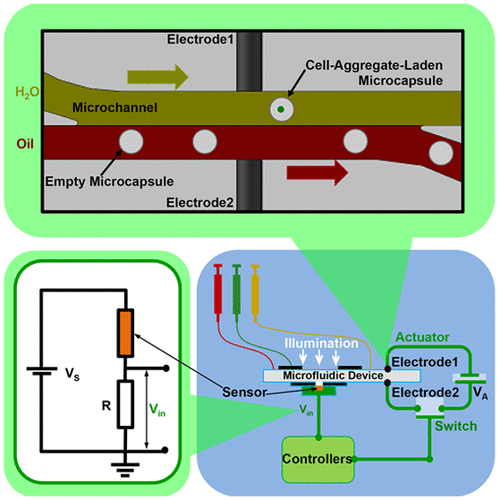Our official English website, www.x-mol.net, welcomes your
feedback! (Note: you will need to create a separate account there.)
Label-Free On-Chip Selective Extraction of Cell-Aggregate-Laden Microcapsules from Oil into Aqueous Solution with Optical Sensor and Dielectrophoresis
ACS Sensors ( IF 8.2 ) Pub Date : 2018-01-24 00:00:00 , DOI: 10.1021/acssensors.7b00834 Mingrui Sun 1 , Patrick Durkin 1 , Jianrong Li 2 , Thomas L. Toth 3, 4 , Xiaoming He 1, 5, 6, 7
ACS Sensors ( IF 8.2 ) Pub Date : 2018-01-24 00:00:00 , DOI: 10.1021/acssensors.7b00834 Mingrui Sun 1 , Patrick Durkin 1 , Jianrong Li 2 , Thomas L. Toth 3, 4 , Xiaoming He 1, 5, 6, 7
Affiliation

|
Microfluidic encapsulation of cells or tissues in biocompatible solidlike hydrogels has wide biomedical applications. However, the microfluidically encapsulated cells/tissues are usually suspended in oil and need to be extracted into aqueous solution for further culture or use. Current extracting techniques are either nonselective for the cell/tissue-laden hydrogel microcapsules or rely on fluorescence labeling of the cells/tissues, which may be undesired for their further culture or use. Here we developed a microelectromechanical system (MEMS) to achieve label-free on-chip selective extraction of cell-aggregate-laden hydrogel microcapsules from oil into aqueous solution. The system includes a microfluidic device, an optical sensor, a dielectrophoretic (DEP) actuator, and microcontrollers. The microfluidic device is for encapsulating cell aggregates in hydrogel microcapsules using the flow-focusing function with microchannels for extracting microcapsules. The optical sensor is to detect the cell aggregates, based on the difference of the optical properties between the cell aggregates and surrounding solution before their encapsulation in hydrogel microcapsules. This strategy is used because the difference in optical property between the cell-aggregate-laden hydrogel microcapsules and empty microcapsules is too small to tell them apart with a commonly used optical sensor. The DEP actuator, which is controlled by the sensor and microcontrollers, is for selectively extracting the targeted hydrogel microcapsules by DEP force. The results indicate this system can achieve selective extraction of cell-aggregate-laden hydrogel microcapsules with ∼100% efficiency without compromising the cell viability, and can improve the purity of the cell-aggregate-laden microcapsules by more than 75 times compared with nonselective extraction.
中文翻译:

利用光学传感器和介电泳技术从细胞中将无聚集细胞的微胶囊从油中无标记选择性提取到水溶液中
生物相容性固体状水凝胶中细胞或组织的微流体封装具有广泛的生物医学应用。但是,微流体包封的细胞/组织通常悬浮在油中,需要将其提取到水溶液中以进一步培养或使用。当前的提取技术或者对于细胞/组织负载的水凝胶微胶囊是非选择性的,或者依赖于细胞/组织的荧光标记,这对于它们的进一步培养或使用可能是不希望的。在这里,我们开发了一种微机电系统(MEMS),以实现从油到水溶液中无标记的芯片上选择性提取载有细胞聚集体的水凝胶微胶囊。该系统包括微流体设备,光学传感器,介电泳(DEP)致动器和微控制器。该微流体装置用于通过具有用于提取微胶囊的微通道的流动聚焦功能将细胞聚集体封装在水凝胶微胶囊中。光学传感器将根据细胞聚集体和周围溶液封装在水凝胶微胶囊中之前的光学特性差异来检测细胞聚集体。之所以使用这种策略,是因为载有细胞的水凝胶微胶囊和空微胶囊之间的光学特性差异太小,无法用常用的光学传感器将它们区分开。由传感器和微控制器控制的DEP致动器用于通过DEP力有选择地提取目标水凝胶微胶囊。
更新日期:2018-01-24
中文翻译:

利用光学传感器和介电泳技术从细胞中将无聚集细胞的微胶囊从油中无标记选择性提取到水溶液中
生物相容性固体状水凝胶中细胞或组织的微流体封装具有广泛的生物医学应用。但是,微流体包封的细胞/组织通常悬浮在油中,需要将其提取到水溶液中以进一步培养或使用。当前的提取技术或者对于细胞/组织负载的水凝胶微胶囊是非选择性的,或者依赖于细胞/组织的荧光标记,这对于它们的进一步培养或使用可能是不希望的。在这里,我们开发了一种微机电系统(MEMS),以实现从油到水溶液中无标记的芯片上选择性提取载有细胞聚集体的水凝胶微胶囊。该系统包括微流体设备,光学传感器,介电泳(DEP)致动器和微控制器。该微流体装置用于通过具有用于提取微胶囊的微通道的流动聚焦功能将细胞聚集体封装在水凝胶微胶囊中。光学传感器将根据细胞聚集体和周围溶液封装在水凝胶微胶囊中之前的光学特性差异来检测细胞聚集体。之所以使用这种策略,是因为载有细胞的水凝胶微胶囊和空微胶囊之间的光学特性差异太小,无法用常用的光学传感器将它们区分开。由传感器和微控制器控制的DEP致动器用于通过DEP力有选择地提取目标水凝胶微胶囊。











































 京公网安备 11010802027423号
京公网安备 11010802027423号